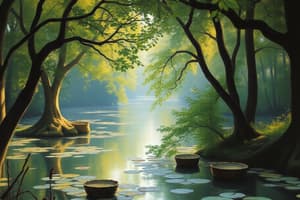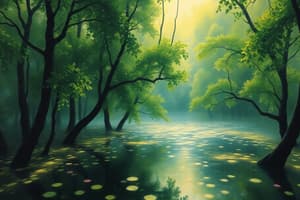Podcast
Questions and Answers
What is the primary source of energy for ecosystems?
What is the primary source of energy for ecosystems?
- Air
- Soil
- Water
- Sunlight (correct)
Hawks eat plants directly to obtain energy.
Hawks eat plants directly to obtain energy.
False (B)
Name one nonliving component of an ecosystem.
Name one nonliving component of an ecosystem.
Water
Plants use sunlight to convert CO2 and water into ______.
Plants use sunlight to convert CO2 and water into ______.
Match the organisms with their roles in the energy flow:
Match the organisms with their roles in the energy flow:
Primary consumers are known as carnivores.
Primary consumers are known as carnivores.
Name two types of consumers in an ecosystem.
Name two types of consumers in an ecosystem.
Fungi and bacteria are examples of ________, which break down dead organic matter.
Fungi and bacteria are examples of ________, which break down dead organic matter.
Match the following types of consumers with their definitions:
Match the following types of consumers with their definitions:
Flashcards are hidden until you start studying
Study Notes
Ecosystem Overview
- Ecosystems consist of living organisms and nonliving things.
- Nonliving elements include water, soil, air, temperature, minerals, and light (sun).
Interactions in Ecosystems
- Living organisms, such as plants, utilize nonliving components for photosynthesis to create food.
- Energy flows through ecosystems: from plants to animals, between animals, and returns to soil upon the death of organisms.
- The sun is the primary source of energy in ecosystems.
Energy Flow and Food Chain
- Example of energy transfer:
- Plants absorb sunlight to make food.
- Primary consumers (herbivores) like mice or rabbits eat plants.
- Secondary consumers (carnivores) such as snakes eat these primary consumers.
- Tertiary consumers, including hawks and eagles, eat other animals, including snakes.
- When a hawk dies, its energy is returned to the soil.
Types of Living Organisms
- Living organisms are categorized based on feeding methods:
- Producers:
- Plants that manufacture their own food using sunlight (photosynthesis).
- Produce glucose which is energy-rich.
- Consumers:
- Organisms that eat plants and/or other animals for energy.
- Classified into three types: primary (herbivores), secondary, and tertiary consumers.
- Decomposers:
- Tiny organisms like fungi and bacteria that break down dead matter into nutrients.
- Decomposition enriches soil fertility by returning small nutrient-rich particles to the soil.
- Producers:
Nutrient Cycle in Ecosystems
- Decomposed matter increases soil fertility, facilitating growth for new plants.
- Nutrients from decomposed organisms benefit the soil, enhancing its viability for future plant life.
Additional Notes
- Activities requiring high energy include exercise and hard work, while those needing low energy include sleeping and resting.
- Plants are unique as they are the only living organisms capable of producing their own food (manufacturing).
Studying That Suits You
Use AI to generate personalized quizzes and flashcards to suit your learning preferences.




